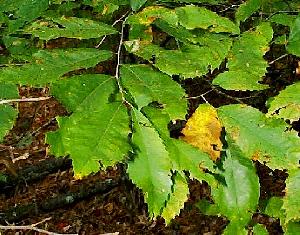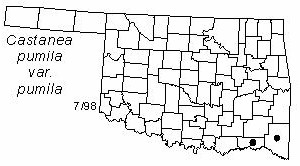
Small tree to 10 m (30 ft) tall, or a shrub. Bark reddish brown, with scaly plates and ridges. Twigs densely hairy when young, becoming shiny brown with densely reddish-hairy buds. Leaves alternate, oblong or elliptical, 7.5-15 cm (3-6 in) long and 3-5 cm (1.2-2 in) wide, with many straight parallel side veins each ending in a short tooth on the coarsely serrate margin, glabrous green above, usually velvety white-hairy below. Fruits are spiny round burs 20-30 mm (0.8-1.2 in) in diameter. Seeds are small chestnuts (15-20 mm) and are edible.
Distribution: Native to most of the southeastern quarter of the U. S.
Comment: This species is affected by the chestnut blight, but not as severely as the American chestnut. The varieties of C. pumila are often considered to be separate species, but some Oklahoma specimens appear to be intermediate. Castanea is the ancient Greek and Latin name for chestnut; pumila refers to the small size of the tree.
Habitat in Oklahoma: mostly oak-hickory forests of the Coastal Plain.
NWI status: none
Distribution in Oklahoma: 
BACK
NEXT
RETURN TO INDEX
Last update: 9/9/99
 Go to Oklahoma Biological Survey Home Page
Go to Oklahoma Biological Survey Home Page
 Disclaimer
Disclaimer